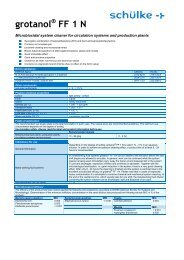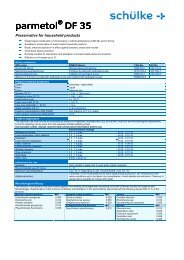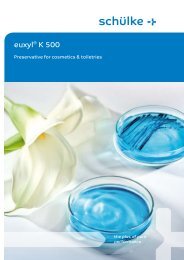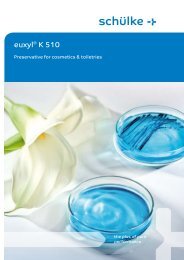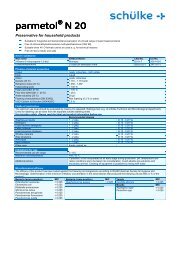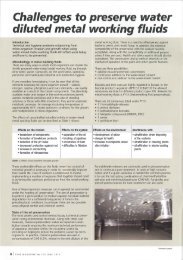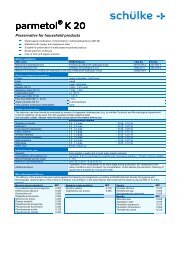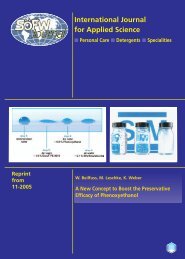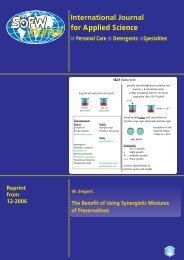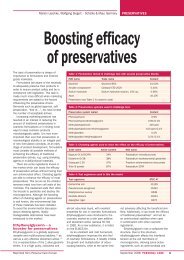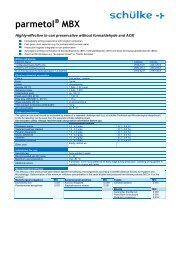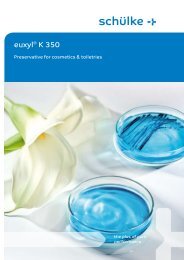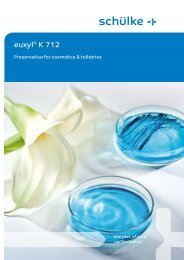Can New Biodegradable Complexing Agents Replace ... - AkzoNobel
Can New Biodegradable Complexing Agents Replace ... - AkzoNobel
Can New Biodegradable Complexing Agents Replace ... - AkzoNobel
You also want an ePaper? Increase the reach of your titles
YUMPU automatically turns print PDFs into web optimized ePapers that Google loves.
1/2-2008<br />
English Edition<br />
International Journal for Applied Science<br />
• Personal Care • Detergents • Specialties<br />
W. Siegert<br />
<strong>Can</strong> <strong>New</strong> <strong>Biodegradable</strong><br />
<strong>Complexing</strong> <strong>Agents</strong> <strong>Replace</strong><br />
Tetrasodium EDTA to Boost<br />
Preservatives?
COSMETICS<br />
PRESERVATIVES<br />
W. Siegert*<br />
<strong>Can</strong> <strong>New</strong> <strong>Biodegradable</strong> <strong>Complexing</strong> <strong>Agents</strong><br />
<strong>Replace</strong> Tetrasodium EDTA to Boost<br />
Preservatives?<br />
Keywords: cosmetic preservative, phenoxyethanol, ethylhexylglycerin, complexing agents<br />
The Test Model<br />
Dilutions of the preservative and combinations<br />
of the preservative/booster are<br />
prepared using sterile hard water according<br />
to the European standard for testing<br />
Preparation of hard water for dilution of products<br />
Solution A: Dissolve 19.84 g anhydrous magenesium chloride (MgCI 2<br />
) or an equivalent of<br />
hydrated magnesium chloride and 46.24 g anhydrous calcium chloride (CaCI 2<br />
) or an equivalent<br />
of hydrated calcium chloride in distilled water and dilute to 1000 ml. Sterilize in the<br />
autoclave. Store the solution at 2 °C to 8 °C for no longer than one month.<br />
Abstract<br />
The continuing discussion of<br />
cosmetic preservatives has limited<br />
the number of accepted<br />
actives that can be practically<br />
used. As a result, a number of different<br />
methods and materials are<br />
being used to boost the activity of<br />
the remaining acceptable preservative.<br />
A cosmetic preservative<br />
based on a combination of the active<br />
ingredient phenoxyethanol<br />
and the skin care additive and<br />
deodorant active ethylhexylglycerin<br />
can be used in many applications.<br />
The additional boosting effect<br />
of tetrasodium EDTA on preservatives<br />
is well known, although the<br />
environmental fate of this material<br />
has been debated. To avoid the<br />
environmental discussion about<br />
complexing agents, readily biodegradable<br />
alternatives were tested<br />
under reproducible conditions.<br />
Solution B: Dissolve 35.02 g sodium hydrogencarbonat (NaHCO 3<br />
) in distilled water and dilute<br />
to 1000 ml. Sterilize by membrane filtration. Store the solution at 2 °C to 8 °C for no longer<br />
than one week.<br />
Hard water: For the preparation of 1 l, place 600 ml to 700 ml distilled water in a 1000 ml<br />
volumetric flask and add 6.0 ml of solution A, then 8.0 ml of solution B. Mix and dilute to<br />
1000 ml with water. The pH of the hard water shall be 7.0 ± 0.2. If necessary adjust the pH<br />
by using a solution of approximately 40 g/l (about 1 mol/l) of sodium hydroxide (NaOH) or<br />
approximately 36.5 g/l (about 1 mol/l) of hydrochloric acid (HCl). The hard water shall be freshly<br />
prepared under aseptic conditions and used within 12 h.<br />
Fig. 1 Water for dilution according to European standard<br />
chemical disinfectants and antiseptics<br />
(Fig. 1) 50 ml portions of the end solutions<br />
are each inoculated with 0.5 ml<br />
microorganism suspension (initial microorganism<br />
count approx. 10 8 cfu/ml) and<br />
stirred. Table 1 shows the test organisms<br />
used. These solutions are streaked out<br />
onto tryptone soya agar or sabouraud-<br />
Test organisms<br />
dextrose 4% agar after 1, 3, 6, and 24<br />
hours. The cultures are incubated for 48<br />
hours at 37 °C, except for Aspergillus<br />
niger, which is incubated for 72 hours<br />
at 25 – 27 °C. The evaluation is made on<br />
the basis of semi-quantitative assessment<br />
of the microbial growth of the<br />
streaks (Table 2).<br />
ATCC-N°<br />
Escherichia coli 11229<br />
Pseudomonas aeruginosa 15442<br />
Staphylococcus aureus 6538<br />
<strong>Can</strong>dida albicans 10231<br />
Aspergillus niger 6275<br />
Table 1 Test organisms<br />
22 SÖFW-Journal | 134 | 1/2-2008
Finally, a preservative that gives you clarity – clear safety,<br />
clear effectiveness, and clear product. Euxyl ® PE 9010 is<br />
globally approved, with no questionable ingredients, keeping<br />
you safe from controversy. Extensive skin compatibility testing<br />
has shown it to be safe for your customers. At the same<br />
time, it’s efficacy is equivalent to the industry standard<br />
preservatives, so your formulation is safe, as well.<br />
Euxyl ® PE 9010 is not only clearly safe, it’s also clear,<br />
literally. It won’t cloud clear gels. It works from<br />
pH 2 to 12, and since it tolerates temperatures<br />
up to 120°C, it also offers clear processing benefits.<br />
No other preservative offers you these clear advantages.<br />
Contact us today and find out more.<br />
Schülke & Mayr GmbH • 22840 Norderstedt • Germany • +49 (0) 40 521 00-0
COSMETICS<br />
PRESERVATIVES<br />
Evaluation Finding Germ count/ml<br />
– no growth 100<br />
+ slight growth approx. 10 3<br />
++ moderate growth approx. 10 4<br />
+++ heavy growth approx. 10 6<br />
C surface covered
COSMETICS<br />
PRESERVATIVES<br />
Fig. 2 Boosting effect of the complexing agents on Euxyl PE 9010<br />
SÖFW-Journal | 134 | 1/2-2008 25
COSMETICS<br />
PRESERVATIVES<br />
Results<br />
Fig. 2 shows the boosting effect of the<br />
complexing agents on Euxyl PE 9010.<br />
All used complexing agents can boost<br />
the effect of the preservative. Noticeably,<br />
tetrasodium dicarboxymethyl glutamate<br />
in combination with citric acid<br />
gives an even better effect than can be<br />
achieved with tetrasodium EDTA. Particularly<br />
unexpected is the good effect of<br />
tetrasodium dicarboxymethyl glutamate<br />
in combination with citric acid against<br />
fungi.<br />
Practical Experience<br />
It is well known that phenoxyethanol and<br />
parabens are inhibited in the presence of<br />
higher amounts of ethoxylated emulsifiers<br />
due to their becoming encapsulated<br />
in micelles. Unfortunately, this cannot<br />
be avoided by adding complexing<br />
agents. A test series similar to the one<br />
described above, but performed in a<br />
shampoo containing 8 % sodium laureth<br />
sulphate, failed completely when tested<br />
with either parabens or with Euxyl PE<br />
9010.<br />
Several challenge tests performed in our<br />
customer service department showed<br />
the benefit of using complexing agents<br />
together with Euxyl PE 9010 in leave-on<br />
formulations. This included some difficult<br />
to preserve sun-care formulations.<br />
Literature<br />
(1) W. Beilfuß, M. Leschke, K. Weber, A <strong>New</strong> Concept<br />
to Boost the Preservative Efficacy of Phenoxyethanol,<br />
SÖFW-Journal, 11-2005<br />
(2) M. Leschke, S. Wüstermann, A Reliable Alternative<br />
for Traditional Preservative Systems,<br />
SÖFW-Journal, 04-2006<br />
(3) M. Leschke, A Multifunctional Ingredient for<br />
Leave on Cosmetics, Cosmetic and Science Technology<br />
2006<br />
(4) European Standard (CEN), Chemical disinfectants<br />
and antiseptics<br />
* Author’s address:<br />
Wolfgang Siegert<br />
Schülke & Mayr GmbH<br />
Special Additive International<br />
22840 Norderstedt<br />
Germany<br />
Email: wolfgang.siegert@schuelke.com<br />
<br />
26 SÖFW-Journal | 134 | 1/2-2008




